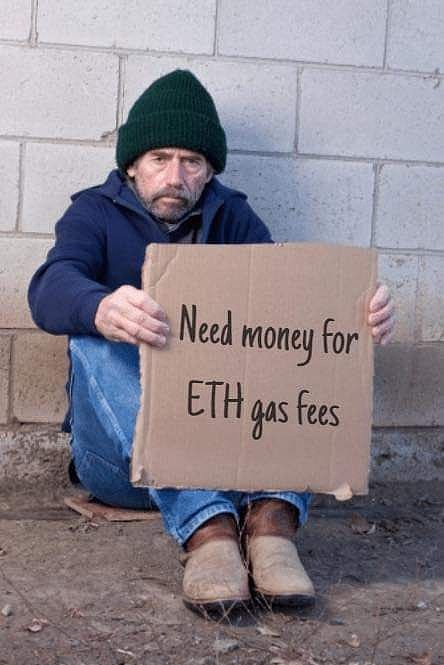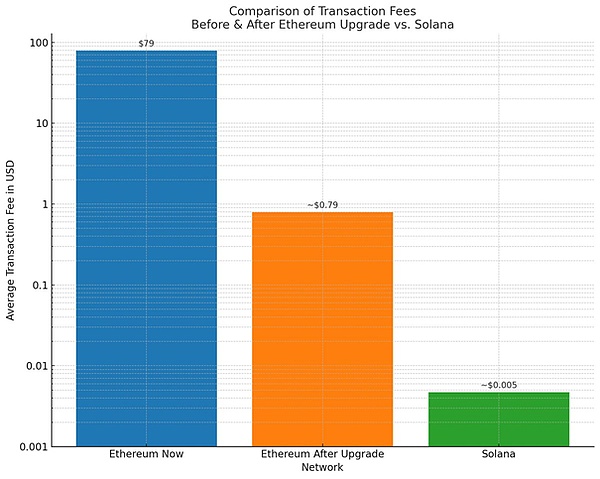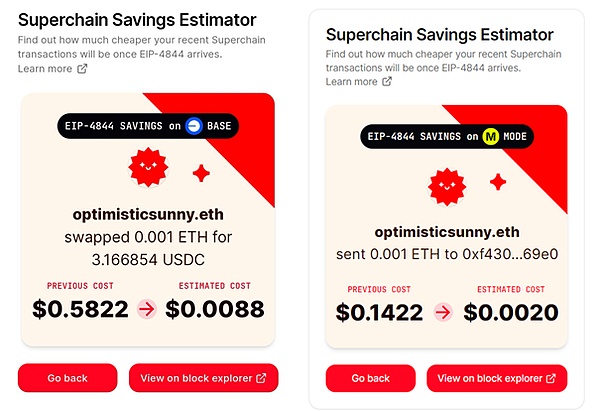Dencun upgrade is finally coming.
As Bitcoin breaks through the highest value in history, the main narrative line belonging to Ethereum has also officially entered the final week of countdown. According to information from the Ethereum Foundation, the Dencun network upgrade has been successfully activated on all testnets. Ethereum will be upgraded on the mainnet at block height 8626176 at 21:55 on March 13, 2024, Beijing time.
This upgrade is of great significance to the Ethereum ecosystem. It is another important development node after the Shapella upgrade.
As an important beginning of the "The Surge" phase of the Ethereum 2.0 upgrade route. The Dencun upgrade had previously been delayed due to bug issues, and was dubbed the "delayed Cancun." Now, after a series of test deployments at the beginning of the year, the Dencun upgrade is ready. In this article, Running Finance will help you understand the "key points" worth paying attention to in this Dencun upgrade through a simple and in-depth perspective, hoping to provide you with in-depth value insights.

Core content: EIP4844
Dencun upgrade mainly covers the consensus layer and execution layer of Ethereum, and the content focuses on fee reduction and speed increase , security and user experience, etc. Among them, EIP-4844 is the core content of this Dencun upgrade, which aims to improve the storage efficiency of the Ethereum system and reduce transaction costs.

High gas fees have always been the biggest obstacle to the development of Ethereum, and the world has been suffering from gas fees for a long time. Users have reportedly paid over $100 in transaction fees during peak hours. According to data from Etherscan, the current average gas fee for swap transactions is approximately $79.

From a short-term perspective, Rollup may be Ethereum's only trustless scalability solution. It can increase Ethereum's processing power without increasing the burden on the network, and does not require users to trust the system. However, given that L1 transaction fees continue to be high, there is an urgent need to take action to promote the transition of the ecosystem to sharding. Since the current Ethereum of sharding is not enough to implement, EIP-4844 essentially provides a stopgap method that can meet the current needs.
EIP-4844 adopts an advanced technology called "Blob", which will be used on the Ethereum network by implementing the Proto-Danksharding process. An innovative temporary data storage mechanism will help reduce L2 transaction fees. L2 networks will be able to store data on L1 more efficiently. Blob data is deleted approximately every two weeks, which is sufficient for L2 to manage and retrieve the data and perform verification. Therefore, blobs are cheaper to store data than regular transaction call data stored indefinitely on the Ethereum blockchain.
EIP-4844 will also introduce Blob Gas, an independent billing system that follows its own pricing rules to calculate base costs. The format of blob data is preset to be consistent with the format in future sharding specifications. This design allows Rollup to effectively alleviate network congestion, while a separate fee market ensures lower fees, making it more economical than the current Calldata storage method.
Offchain Labs developers said, "Assuming current network traffic levels, once Dencun is implemented, the gas fee for the second-layer network should immediately drop by 75%." Also Some developers said, "The Dencun upgrade is like upgrading a road with only one lane to a four-lane highway, bringing Ethereum into the modern transportation era."

In Layer 2 transaction costs, the largest expense item is " "Call Data" fee, which currently accounts for more than 80% of the total Layer 2 transaction fee. The Blob mechanism can temporarily store data, which is crucial for short-term transaction verification, and the data can be deleted later to avoid network storage overload. The integrity and security of the data processing process are guaranteed by encryption technology that detects data changes.
According to previous analysis reports, Proto-Danksharding will limit the number of Blobs in each block to 16, and the size of a single Blob will not exceed 128KB. It is expected that This provides an increase of approximately 2MB in block space. The new data space will allow Optimistic Rollup and Zero-Knowledge Rollup to publish proof of transaction data on the chain, using Blobs instead of "Call Data" to provide actual data. Blob data will be cleared after two weeks, and "Call Data" will be permanently stored on the Ethereum blockchain.
The EIP-4844 proposal not only introduces the Blob mechanism for transmitting transactions, but also implements comprehensive system changes such as execution layer logic, verification rules, and multi-dimensional fee markets. , these changes will lay the foundation for the realization of complete "sharding" in the future.
How will Gas charges change?
So, once the Dencun upgrade is completed, how will the gas fee change due to the impact of the EIP-4844 proposal?

Optimism has launched a website to predict the changing trend of Gas Fee after the introduction of super chain Blob. But the site's forecasts are based on the simplifying assumption of a base Blob Gas rate of 4.2 gwei, so actual numbers may be off.
Predictions indicate that a blob of approximately 125 kB will cost approximately 0.001 ETH. Currently, the cost of 125 kB of Call Data is approximately 30 gwei per Gas times 16 Gas per byte times 125,000 Gas (approximately equal to 0.06 ETH).
Rollups currently generate approximately 60 transactions per second (TPS). If each transaction is about 200B, then they process about 12kB per second, and each Eth block is about 144kB. In the initial goal, for 3 blobs (3*125kB = 475 kB) in the EIP-4844 proposal, Rollup will only occupy about 30% of the data availability capacity. Unless Blobs have other sources of demand (such as inscriptions), expect the following to occur in the short term once Rollups are migrated to Blobs:
• The cost of Blobs will increase Very cheap (less than 0.001 ETH)
• Rollups transaction fees will also be very cheap (less than $0.05)
*The picture below shows the gas fee change test results posted by Twitter users.

What did the other proposals say?
(1) EIP-1153: Transient storage opcode, used to process data that is only needed for a short period of time. Transient storage opcodes allow smart contracts to use a memory-like storage space when processing data. This storage space differs from permanent storage in that its contents are cleared after each transaction, much like a temporary notepad is erased after its contents are used up. It has the following characteristics:
• Temporary:The values in transient storage are discarded after each transaction. Will not be stored long term.
• Performance advantages:Because it does not require disk access, it is cheaper to use.
• Support for smart contract access:Smart contracts can access transient storage through two new opcodes, which means Contracts can read and write this temporary data.
• Convenience:When using transient storage, the client does not need to pay gas fees in advance to load the original data, and There is no need to clean the storage tank after use, which makes the entire process more efficient and cheaper.
(2) EIP-4788: The beacon block root in the Ethereum Virtual Machine helps the Ethereum Virtual Machine (EVM) communicate with the consensus layer more securely Interaction, without relying on external trust sources, EVM can directly access and verify these data, improving the security and reliability of the system. This function supports the following application scenarios:
a. Pledge pool. Staking pools more reliably verify participants’ token amounts and status, reducing the possibility of fraud and errors.
b. Re-pledge. Related data can be directly verified, making the process of changing staking settings smoother and safer.
c. Cross-chain bridge. Smart contract bridges can more efficiently verify transactions and status, thereby increasing the security of cross-chain interactions.
d.MEV mitigation. MEV (Miner Extracted Value) is a means of profiting from block construction by optimizing the order of transactions. Using beacon block roots, more effective strategies can be designed to reduce the impact of MEV, making transactions more fair and transparent.
(3) EIP-5656: MCOPY, is an efficient EVM (Ethereum Virtual Machine) instruction used to copy memory areas. It can be found in the Solidity, Vyper, and Fe compilers and is used to implement exact word memory copy and partial word memory copy. EIP-5656 helps improve the performance of the Ethereum network, especially in smart contract execution, by introducing the MCOPY opcode. This is an important improvement for developers as it allows them to create more efficient and faster smart contracts, with the overhead of calling identity precompilation reduced from 700 Gas to 100 Gas.
(4) EIP-6780: Used to remove the SELFDESTRUCT opcode. In the original design, the SELFDESTRUCT function of the Ethereum smart contract was implemented by calling a special operation code (opcode). When the smart contract calls SELFDESTRUCT, the code in the contract is destroyed and the remaining ether and storage space are sent to the specified address.
This function is originally designed to clean up when the contract execution is completed or a serious error occurs.
When a smart contract is no longer needed, storage space can be released through self-destruction and the remaining ether coins can be sent to the specified address, thereby avoiding waste of resources. Using SELFDESTRUCT will delete all code and storage information for the account. But in the future design of Verkle trees, this operation will no longer be possible. Because in the future design, each account's information will be scattered and stored in many different account keys, and there will be no obvious connection between these account keys and the root account. The adoption and implementation of the EIP-6780 proposal will help improve the security of the Ethereum network and prevent the risk of fund loss due to contract self-destruction.

(5) EIP-7044: An improvement proposal for the Ethereum staking withdrawal mechanism. The main purpose of this proposal is to simplify and improve the withdrawal mechanism of Ethereum staking so that voluntary withdrawals signed before the Capella upgrade can be permanently effective. Such improvements can ensure safer staking operations while also improving user experience. By implementing EIP-7044, the Ethereum network can better handle validators and staking-related operations, thereby enhancing the stability and reliability of the entire network.
(6) EIP-7045: An Ethereum improvement proposal for network proof slots to improve the performance of the Ethereum network by increasing the number of proof slots. Security and speed of transaction confirmation. Proof slots are a concept in the Ethereum protocol that are closely related to the behavior of validators and the security of the network. By expanding the scope of the attestation slots, the network's ability to handle large numbers of validators is increased, while also increasing the security of the entire network.
(7) EIP-7514: A proposal to improve the growth method of Ethereum staking validators by changing the growth method of the maximum number of validators from exponential The growth is changed to linear growth, and by setting a fixed maximum churn limit, the number of validators entering or leaving the network in each epoch period is limited to deal with the rapid growth of Ethereum pledges. The proposal aims to mitigate the negative externalities of a very high total supply of staked ETH until an appropriate solution is implemented.
(8) EIP-7516: An improvement proposal to reduce the cost of data usage, allowing users to programmatically calculate the cost of Blob data usage. The advantage of this is that users can calculate and use data according to their actual needs, thus reducing the cost of data usage. In addition, the concept of Blob Gas futures was also mentioned in the proposal. Blob Gas futures are a financial instrument that allows users to lock in future Blob data usage costs, thereby eliminating the risk caused by data usage cost fluctuations.
Competition may have just begun
Although Ethereum Gas charges have been reduced through the Dencun upgrade, but its solution still faces challenges such as network fragmentation and user experience issues. These challenges may continue to limit Ethereum’s ability to attract small transactions.
From an economic perspective, the average cost of NFT transactions on the Ethereum platform is approximately $140, which is generally a relatively high expenditure for users , especially when transaction fees exceed the value of the NFT itself. Therefore, high transaction fees drive users to explore more cost-effective alternatives.
For example, Solana, a Layer 1 blockchain, has transaction fees much lower than Ethereum, with an average transaction cost of only 0.000036 SOL, which is equivalent to approximately US$0.0047. This significant cost advantage attracts many users who want to reduce expenses, especially those who frequently trade NFTs.
In addition, as smart contracts become more complex, ensuring their security and reliability gradually becomes an ongoing challenge. Malicious behavior or programming errors may lead to major security incidents.
The challenges in the encryption world are continuous, but the Dencun upgrade is only temporary. As Vitalik said, Ethereum requires three key technology transitions to achieve an open, global and permissionless experience. Now, everything has just begun.
 Joy
Joy











